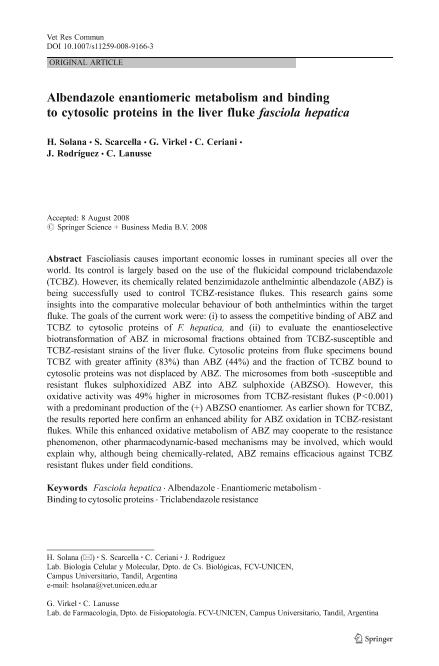Mostrar el registro sencillo del ítem
dc.contributor.author
Solana, Hugo Daniel

dc.contributor.author
Scarcella, Silvana Andrea

dc.contributor.author
Virkel, Guillermo Leon

dc.contributor.author
Ceriani, Maria Carolina

dc.contributor.author
Rodriguez, Julio Armando

dc.contributor.author
Lanusse, Carlos Edmundo

dc.date.available
2020-05-19T15:12:49Z
dc.date.issued
2008-08
dc.identifier.citation
Solana, Hugo Daniel; Scarcella, Silvana Andrea; Virkel, Guillermo Leon; Ceriani, Maria Carolina; Rodriguez, Julio Armando; et al.; Albendazole enantiomeric metabolism and binding to cytosolic proteins in the liver fluke Fasciola hepatica; Springer; Veterinary Research Communications; 33; 2; 8-2008; 163-173
dc.identifier.issn
0165-7380
dc.identifier.uri
http://hdl.handle.net/11336/105463
dc.description.abstract
Fascioliasis causes important economic losses in ruminant species all over the world. Its control is largely based on the use of the flukicidal compound triclabendazole (TCBZ). However, its chemically related benzimidazole anthelmintic albendazole (ABZ) is being successfully used to control TCBZ-resistance flukes. This research gains some insights into the comparative molecular behaviour of both anthelmintics within the target fluke. The goals of the current work were: (i) to assess the competitive binding of ABZ and TCBZ to cytosolic proteins of F. hepatica, and (ii) to evaluate the enantioselective biotransformation of ABZ in microsomal fractions obtained from TCBZ-susceptible and TCBZ-resistant strains of the liver fluke. Cytosolic proteins from fluke specimens bound TCBZ with greater affinity (83%) than ABZ (44%) and the fraction of TCBZ bound to cytosolic proteins was not displaced by ABZ. The microsomes from both -susceptible and resistant flukes sulphoxidized ABZ into ABZ sulphoxide (ABZSO). However, this oxidative activity was 49% higher in microsomes from TCBZ-resistant flukes (P<0.001) with a predominant production of the (+) ABZSO enantiomer. As earlier shown for TCBZ, the results reported here confirm an enhanced ability for ABZ oxidation in TCBZ-resistant flukes. While this enhanced oxidative metabolism of ABZ may cooperate to the resistance phenomenon, other pharmacodynamic-based mechanisms may be involved, which would explain why, although being chemically-related, ABZ remains efficacious against TCBZ resistant flukes under field conditions.
dc.format
application/pdf
dc.language.iso
eng
dc.publisher
Springer

dc.rights
info:eu-repo/semantics/openAccess
dc.rights.uri
https://creativecommons.org/licenses/by-nc-sa/2.5/ar/
dc.subject
FASCIOLA
dc.subject
ALBENDAZOLE
dc.subject
ENANTIOMERS
dc.subject
METABOLISM
dc.subject.classification
Otras Ciencias Veterinarias

dc.subject.classification
Ciencias Veterinarias

dc.subject.classification
CIENCIAS AGRÍCOLAS

dc.title
Albendazole enantiomeric metabolism and binding to cytosolic proteins in the liver fluke Fasciola hepatica
dc.type
info:eu-repo/semantics/article
dc.type
info:ar-repo/semantics/artículo
dc.type
info:eu-repo/semantics/publishedVersion
dc.date.updated
2020-04-17T14:37:36Z
dc.journal.volume
33
dc.journal.number
2
dc.journal.pagination
163-173
dc.journal.pais
Alemania

dc.journal.ciudad
Berlín
dc.description.fil
Fil: Solana, Hugo Daniel. Universidad Nacional del Centro de la Provincia de Buenos Aires. Facultad de Ciencias Veterinarias. Laboratorio de Biología Celular y Molecular; Argentina
dc.description.fil
Fil: Scarcella, Silvana Andrea. Universidad Nacional del Centro de la Provincia de Buenos Aires. Facultad de Ciencias Veterinarias. Laboratorio de Biología Celular y Molecular; Argentina. Consejo Nacional de Investigaciones Científicas y Técnicas; Argentina
dc.description.fil
Fil: Virkel, Guillermo Leon. Consejo Nacional de Investigaciones Científicas y Técnicas; Argentina. Universidad Nacional del Centro de la Provincia de Buenos Aires. Facultad de Ciencias Veterinarias. Departamento de Fisiopatología. Laboratorio de Farmacología; Argentina
dc.description.fil
Fil: Ceriani, Maria Carolina. Universidad Nacional del Centro de la Provincia de Buenos Aires. Facultad de Ciencias Veterinarias. Laboratorio de Biología Celular y Molecular; Argentina. Consejo Nacional de Investigaciones Científicas y Técnicas; Argentina
dc.description.fil
Fil: Rodriguez, Julio Armando. Consejo Nacional de Investigaciones Científicas y Técnicas; Argentina. Universidad Nacional del Centro de la Provincia de Buenos Aires. Facultad de Ciencias Veterinarias. Laboratorio de Biología Celular y Molecular; Argentina
dc.description.fil
Fil: Lanusse, Carlos Edmundo. Consejo Nacional de Investigaciones Científicas y Técnicas; Argentina. Universidad Nacional del Centro de la Provincia de Buenos Aires. Facultad de Ciencias Veterinarias. Departamento de Fisiopatología. Laboratorio de Farmacología; Argentina
dc.journal.title
Veterinary Research Communications

dc.relation.alternativeid
info:eu-repo/semantics/altIdentifier/doi/http://dx.doi.org/10.1007/s11259-008-9166-3
dc.relation.alternativeid
info:eu-repo/semantics/altIdentifier/url/https://link.springer.com/article/10.1007/s11259-008-9166-3
Archivos asociados
